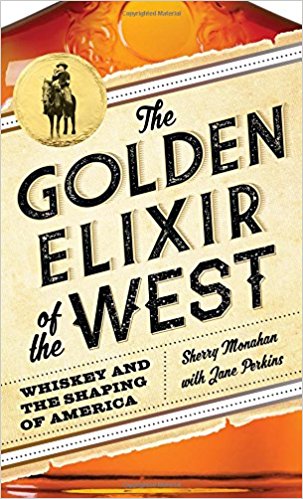The Golden Elixir of the West
 Buy the Book: Amazon, Barnes & Noble, IndieBound, Books-A-Million
Buy the Book: Amazon, Barnes & Noble, IndieBound, Books-A-Million Published by: TwoDot
Release Date: October 4, 2017
Pages: 248
ISBN13: 978-1493028498
Overview
Distilleries are the new microbreweries, cropping up all over the West and producing brands that emulate the predecessors that were made in copper stills by emigrants and served in saloons and dance halls. This history of the spirit and its origins and migration across the country—and its place in shaping the West—celebrates the story of the golden elixir through first-hand accounts, evocative photographs, and historic cocktail recipes. Whiskey was the golden elixir of the West and king of the distilled spirits. It was an integral part of the great western expansion and has strong ties to early explorers, pioneers, the railroads, and the cattle era. It was sold as medicine, used to barter with, and often gave courage where there was none. Whiskey’s role in shaping the West, and its rise to prominence over rum or vodka, has its roots in the early days of the United States. It’s a story of taxes, availability, and profits.
Praise
A Three-Finger Whiskey Reader
In The Golden Elixir of the West: Whiskey and the Shaping of America, authors Sherry Monahan and Jane Perkins take a discerning look at the iconic tonic and its formative role in the American West. What they find is a rich history filled with nostalgia, humor, tragedy, and success. Taking you from whiskey’s storied past in the Wild West to distilleries today, The Golden Elixir offers historic cocktail recipes, expert comparisons of the drink through the years, a behind-the-scenes look at the world’s first ski-in gastro distillery, and holiday gift guides to help you pair each whiskey drinker on your list with the perfect tipple. Cowboys & Indians magazine
Excerpt
Whiskey shipments, whether by rail, freight, or ship were in danger of being stolen or lost. Quite a few ships with whiskey in their cargo holds were lost to the turbulent rivers in the West from the early to mid-1800s. In the 1890s dreams of buried liquid gold and a quest to recover it was on many pioneer’s mines. In 1893 a Kansas newspaper reported on the buried whiskey and recovery efforts. They reported, “…The oldest wreck of which there is now any knowledge…is of the Spanish boat that was sunk at the mouth of the River Des Peres in south St. Louis. It is also said, by the way, that the Spanish vessel hand on board a goodly stock of liquors…Just think how far a barrel of goods made ‘in the early years’ and thus preserved would go in this time of quickly-aged whiskies!” According to them the oldest wreck with any first-hand knowledge was a government steamer that sank in the Missouri river in the early thirties at Arrow Rock Island near Boonville. Its cargo included gold and whiskey and it was rumored that some of the whiskey was privately recovered. The Arabia, a side-wheel steamboat, was another ship that went down in 1856 below Parkville, also in the Missouri river. Her journey began on August 1, 1856 at St. Louis and was bound for Omaha, Nebraska and Council Bluffs, Iowa. She was loaded with pork, Wedgewood queens-ware, and 200 to 600 barrels of high quality whiskey. Captain Dan Able guided her like he had done before and had no trouble until August 20 in Parkville, Missouri. As he tried to put the maneuver the boat to the landing, it was snagged and began taking on water. Newspaper reports claim the captain lost his head and panicked and swung the boat into the stream of the water. After the ship drifted downstream the engines could not hold against the current and the boat hit the opposite bank. Even though the boat didn’t completely sink, the whiskey and queens-ware were complete under water in the boat’s hold. Like the government boat, rumors of whiskey rescue from the Arabia swirled. The Salina Daily Republican smirked, “…If it is so, the finders must have lost their heads sampling the quality of goods, and thus forgot the lay of the river at the lucky point.” Not long after the Arabia was sunk, the Ogden, captained by Jim Bissell, suffered the same fate. It sunk a few miles above Jefferson City and was thought to be the one with the best hope of recovery. Two years after the Ogden went down, the Twilight was sunk.